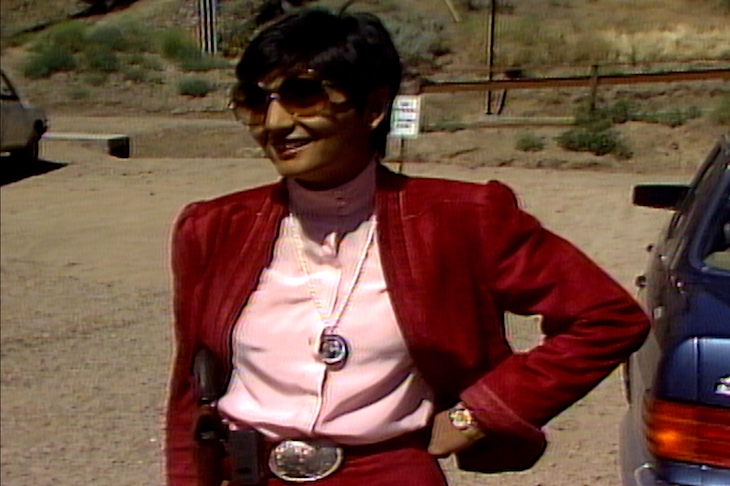I have decided to set up a cult, which you are all welcome to join, especially those of you who are young and very attractive or stupendously rich. The former will get exclusive membership of my JiggyJiggy Fun Club™, while the latter will be essential in financing all the cool shit I need on my 500-square-mile estate, viz: hunt stables and kennels, helipad, private games room with huge comfy chair, water slides, grouse moor, airstrip, barracks for my cuirassiers, volcano with battery of rockets inside, and so on.
What gave me the idea was this new Netflix documentary series everyone is talking about called Wild Wild Country. It tells the story of the Bhagwan Shree Rajneesh, the bearded guru who in the early 1980s decamped from India with his thousands of followers to set up a utopian colony on a remote and beautiful ranch in the wilds of Oregon.
If you didn’t know it was all going to go horribly wrong, you might find the early episodes ever so slightly dull. ‘Yeah, yeah. Beard. Twinkly eyes. Namaste. Hideous orange clothes. Rolls-Royce. Free love. Money-making machine. We got it,’ I muttered after the first part, which lasted an hour but felt like two. For example, the bearded guy (not that that narrows it down much) who used to be a hotshot LA lawyer but then became the cult’s attorney: did we really need to have quite so much of him expatiating ad nauseam in his neat clothes and stripped-wood loft space on how delightful and misunderstood the cult was, how charismatic its leader, how foxily cunning and dedicated its modus operandi?
This is the series’ blessing and curse. Directors Mclain and Chapman Way have secured in-depth interviews with all the story’s surviving participants. Very in-depth. Yes, indeed, it is a coup to have got Ma Anand Sheela, the remarkably determined, supremely unapologetic woman who ran the operation — and later got a 20-year jail sentence — to open up. At the same time, though, as is the modern style, the directors prefer merely to point the camera and let the viewers make up their minds what to think. Which leaves you feeling a bit rudderless as you watch, not least because Sheela and co remain utterly convinced that Rajneesh and his cult were worthy and good. You end up almost being programmed to their way of thinking.
How weird, dangerous and corrupt was the cult? Dangerous enough, we later learn, deliberately to have infected with salmonella 751 people in order to incapacitate voters so as to win a local election. Weird enough for you to be appalled if one of your kids joined because they’d end up with that far-off look in their eyes and you’d barely see them again. Even so — hence my intro —there’s a part of me that thinks: well if that’s what these people are into why shouldn’t they be able to set up their private fantasy worlds in the middle of nowhere? Especially when, as in my cult, the uniforms are going to be so much better. I’ve not yet decided what the girls wear, but we boys all get to dress like Mr Darcy in Pride and Prejudice.
Indian Summer School (C4) is the latest variant on one of my favourite reality TV genres: unteachables go to brat camp. In this case, the tough reformatory for five naughty English kids is the Doon School — ‘India’s Eton’ — a magnificent boarding school set in 70 acres of grounds abundant with trees and flowers in the foothills of the Himalayas north of Delhi. So — not much real hardship: just homesickness and exposure to the kind of old-school rigour, discipline and traditionalism which, in India at least, have yet to be killed by trendy headmasters who think it’s a good idea to give boys the option of wearing skirts or to invite Laura Bates from the Everyday Sexism Project to come and lecture them on how they’re all potential rapists.
The most delinquent kid, Jake, has already been sent home, thank heaven. It was too excruciating to watch this charmingly quaint establishment, with its well-behaved, hard-working boys, and its kindly, firm but fair staff, being exposed to a horror who smuggles in booze, shaves off his classmate’s eyebrows for a joke, and sunbathes on the roof rather than attends lessons.
That will leave space for the series to focus on more positive participants in the experiment: Ethan, the Welsh would-be transsexual learning maybe to be a bit less of a needy, pouty snowflake; Harry, coping with his rages; and (my favourite) dear, sweet, gangly, ginger Jack, who has spent his schooling in rough comps being bullied and who is now discovering how different learning is when no one is mucking about in class and the teachers really care.







Comments